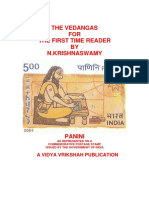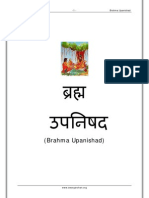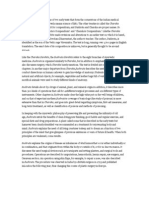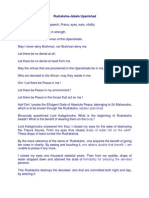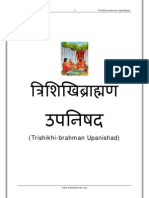Brahma Vidya
Brahma Vidya
Uploaded by
hjoshi1297Copyright:
Available Formats
Brahma Vidya
Brahma Vidya
Uploaded by
hjoshi1297Original Description:
Copyright
Available Formats
Share this document
Did you find this document useful?
Is this content inappropriate?
Copyright:
Available Formats
Brahma Vidya
Brahma Vidya
Uploaded by
hjoshi1297Copyright:
Available Formats
Sacred Text
-1 -
Brahmavidya Upanishad
(Brahmavidy Upanishad)
www.swargarohan.org
Sacred Text
-2 -
Brahmavidya Upanishad
UPANISHADS: AN INTRODUCTION
The word 'Upanishad' in Sanskrit language means upa (near), ni (down) and shad (to
sit), which can be summed up as 'to sit down near' (and receive instructions). The teacher
and student or a spiritual master and his disciples setting were not always prevalent in strict
sense. In some cases, it was husband answering questions about immortality to his wife or
a teenage boy was being taught by Yama (God of Death). The teachers, in some cases were
women sages and the seekers of inspiration were kings. Besides dialogues, Upanishads also
contain narrations, similes, metaphors, illustrations and symbolism.
In the quietude of caves and monasteries or ashrams situated on the banks of holy
Ganges, this mystic knowledge was exchanged for centuries. It can be said that Upanishads
are collection of writings representing oral transmission of such knowledge.
Most of the Upanishads are either commentary on or are an extension of four Vedas
and in most cases constitute Vedanta (the end or an ultimate part of Veda). The
characteristics of the Upanishads are their universality and the total absence of any
dogmatism. Upanishads elaborate upon highest metaphysical state, beyond which is the
realm of Silence.
Upanishads are considered as the backbone of Hinduism. The thoughts expressed
inside Upanishadic cluster forms the core of Indian philosophy. One can find doctrines of
Karma (action), Yoga (union), Punarjanma (rebirth), moksha (liberation), atma (soul) and
brahman (super soul), inside these scriptures. Upanishads also gives valuable insight into
Hindu belief system behind the creation of universe and the reasons behind its sustenance.
According to Historians, Upanishads were composed between year 800-400 B.C.
Experts differ on total number of Upanishads, but most agree on 108. Major among them
are Chhandogya & Kena (Sam Veda); Aitareya & Kaushitaki (Rig Veda); Katha, Taittiriya,
Brihadaranyaka, Svetasvatara, Isa & Prasna (Yajur Veda); Mundaka & Mandukya (Atharva
Veda). From various elaboration found inside Upanishadic verses, it can be said that, sages
like Yagnavalkya, Uddalaka, Aitareya, Pippalada, Sanat Kumar, Shwetaketu, Shandilya,
Manu and even Maharshi Narada disseminated Upanishadic knowledge and thus, can be said
to be their authors.
Upanishads are acknowledged as pinnacle of human wisdom. None other scripture
of that time can claim to contain such sublime and noble thoughts as found inside
Upanishads. Written almost at the time of the dawn of civilization, Upanishads continues to
evoke tremendous interest even today, among literates of both, East as well as West.
www.swargarohan.org
Sacred Text
-3 -
Brahmavidya Upanishad
www.swargarohan.org
Sacred Text
-4 -
Brahmavidya Upanishad
www.swargarohan.org
Sacred Text
-5 -
www.swargarohan.org
Brahmavidya Upanishad
Sacred Text
-6 -
www.swargarohan.org
Brahmavidya Upanishad
Sacred Text
-7 -
www.swargarohan.org
Brahmavidya Upanishad
Sacred Text
-8 -
Brahmavidya Upanishad
www.swargarohan.org
Sacred Text
-9 -
Brahmavidya Upanishad
www.swargarohan.org
You might also like
- Essence of Brahmanda PuranaDocument93 pagesEssence of Brahmanda Puranahariharv100% (1)
- Vishnu PuranDocument6 pagesVishnu Puranshyam p joshiNo ratings yet
- Kolaru ThirupathigamDocument14 pagesKolaru ThirupathigambcramcNo ratings yet
- The Vedangas FOR The First Time Reader BY N.Krishnaswamy: A Vidya Vrikshah PublicationDocument92 pagesThe Vedangas FOR The First Time Reader BY N.Krishnaswamy: A Vidya Vrikshah PublicationSaiKishore100% (3)
- VarahaDocument19 pagesVarahahjoshi1297No ratings yet
- Brahma BinduDocument4 pagesBrahma Binduhjoshi129775% (4)
- Easyjet Analysis ReportDocument16 pagesEasyjet Analysis ReportAfsheen Danish Naqvi100% (1)
- AtmabodhaDocument5 pagesAtmabodhahjoshi1297No ratings yet
- KathaDocument11 pagesKathahjoshi1297100% (1)
- Kai ValyaDocument5 pagesKai Valyahjoshi1297No ratings yet
- BrahmaDocument5 pagesBrahmahjoshi1297No ratings yet
- Vasudev ADocument5 pagesVasudev Ahjoshi1297No ratings yet
- Yoga TatvaDocument11 pagesYoga TatvaShuklaPradeepNo ratings yet
- Yoga ShikhaDocument26 pagesYoga Shikhahjoshi129780% (5)
- Brahmavidya MeditationDocument14 pagesBrahmavidya MeditationPranavNo ratings yet
- Selections: Bharthruhari SubhashitaDocument15 pagesSelections: Bharthruhari SubhashitaRavi Kiran MachirajuNo ratings yet
- The Sushruta Samhita Is One of TwoDocument2 pagesThe Sushruta Samhita Is One of Twodrpankaj28No ratings yet
- Shri DWADASHA PANJARA STOTRAM (ALL LANGUAGES)Document13 pagesShri DWADASHA PANJARA STOTRAM (ALL LANGUAGES)Dr. Jayanthi V.S.No ratings yet
- Spiritual Karma Magazine 68. Published by Swamiji Sri Selvam Siddhar-Dr Commander Selvam-Shiva Vishnu TempleDocument72 pagesSpiritual Karma Magazine 68. Published by Swamiji Sri Selvam Siddhar-Dr Commander Selvam-Shiva Vishnu Templetexastemple100% (2)
- The Qualities of Tridosha and Triguna and Their Relation With Adherence - 05-11-2014 PDFDocument19 pagesThe Qualities of Tridosha and Triguna and Their Relation With Adherence - 05-11-2014 PDFDrPraveenAngadi100% (2)
- DhanurvedaDocument17 pagesDhanurvedajaytri rajgorNo ratings yet
- 11 Mukhi HanumanDocument3 pages11 Mukhi HanumanjanakrajchauhanNo ratings yet
- Gyan GanjDocument3 pagesGyan GanjBaba HimanathNo ratings yet
- A Powerful Shani StotraDocument1 pageA Powerful Shani StotraneerajkrsnaNo ratings yet
- SwarodayaDocument34 pagesSwarodayaAnurag AnupamNo ratings yet
- ADVAITA-SAADHANAADiscourses by Kanchi Mahaswamigal PDFDocument211 pagesADVAITA-SAADHANAADiscourses by Kanchi Mahaswamigal PDFShridhar IyerNo ratings yet
- Choosing A Path - Rama, Swami, 1925Document228 pagesChoosing A Path - Rama, Swami, 1925Subala PeriyasamyNo ratings yet
- Pavamana SukthamDocument6 pagesPavamana SukthamSrinidhi SrinathNo ratings yet
- The Power of Syllable OṀ in Hindu Thought - Creative and Unifying Qualities of Sound PDFDocument34 pagesThe Power of Syllable OṀ in Hindu Thought - Creative and Unifying Qualities of Sound PDFBrad YantzerNo ratings yet
- Sodasanama MurugaDocument2 pagesSodasanama MurugaSanatana DharmaNo ratings yet
- MedhasuktamDocument2 pagesMedhasuktamReji Kumar P KNo ratings yet
- Arthur Avalon - Shakta and ShaktiDocument370 pagesArthur Avalon - Shakta and ShaktirelristeinNo ratings yet
- Kena Upanishad: Brahmanam of The SamavedaDocument9 pagesKena Upanishad: Brahmanam of The Samavedapsrve696No ratings yet
- Guru Bhakti Yoga SivanandaDocument122 pagesGuru Bhakti Yoga Sivanandanirbhaynaad100% (1)
- Sri Sukta Homa Writeup PDFDocument1 pageSri Sukta Homa Writeup PDFmurthy6332No ratings yet
- Morning MantramDocument6 pagesMorning MantramBagus Adi MahayanaNo ratings yet
- North America Institute of Vihangam YogaDocument20 pagesNorth America Institute of Vihangam Yogasahayrajesh100% (1)
- Sat-Darshanam IDocument168 pagesSat-Darshanam ITenneti Sri RamNo ratings yet
- An Upanishad TextDocument4 pagesAn Upanishad TextSivasonNo ratings yet
- Essence of Varaha PuranaDocument66 pagesEssence of Varaha PuranahariharvNo ratings yet
- Kena UpanishadDocument5 pagesKena Upanishadseraphimuse100% (1)
- RudrakshDocument2 pagesRudrakshक्रीं मातेश्वरी महाकालीNo ratings yet
- Amritabindu UpanishadDocument7 pagesAmritabindu Upanishaddavidescu5costin100% (1)
- Ishads - TheDocument197 pagesIshads - TheGustav Son100% (1)
- Rudraksha Jabala UpanishadDocument5 pagesRudraksha Jabala Upanishadvk488No ratings yet
- 06 - Chapter 1Document53 pages06 - Chapter 1Rohit D KashyapNo ratings yet
- Saptha Mukhi Hanumath KavachamDocument7 pagesSaptha Mukhi Hanumath KavachamPuducode Rama Iyer RamachanderNo ratings yet
- Sandhya VandaneDocument3 pagesSandhya VandanebhatdinuNo ratings yet
- Devi Bhagavattam Book 2Document48 pagesDevi Bhagavattam Book 2Axel Valenzuela BylanderNo ratings yet
- Gopala KavachamDocument3 pagesGopala KavachamAnonymous iIgrKVwHNo ratings yet
- Rudraksha Research ReferencesDocument2 pagesRudraksha Research Referencessiva100% (1)
- Bhaja Govindam in Sanskrit Transliteration and TranslationDocument39 pagesBhaja Govindam in Sanskrit Transliteration and TranslationnanakpandyaNo ratings yet
- Osfnd Gou: Do It Yourself Vaidik HavanDocument42 pagesOsfnd Gou: Do It Yourself Vaidik Havansritha_87100% (1)
- Gyan Ganga English PDFDocument392 pagesGyan Ganga English PDFAnonymous R8qkzgNo ratings yet
- Aditya Hrudaya SthotramDocument8 pagesAditya Hrudaya SthotramRajiv Warrier100% (2)
- Yoga KundaliniDocument13 pagesYoga Kundalinihjoshi1297No ratings yet
- Yoga ShikhaDocument26 pagesYoga Shikhahjoshi129780% (5)
- Yoga TatvaDocument11 pagesYoga TatvaShuklaPradeepNo ratings yet
- Yoga ChudamaniDocument11 pagesYoga Chudamanihjoshi1297No ratings yet
- YajnavalkyaDocument5 pagesYajnavalkyahjoshi1297No ratings yet
- Kali Santa RanDocument3 pagesKali Santa Ranhjoshi1297No ratings yet
- SH Vet Ash VatarDocument10 pagesSH Vet Ash Vatarhjoshi1297No ratings yet
- Tait T IriyaDocument25 pagesTait T Iriyahjoshi1297No ratings yet
- Trishikkhi BrahmanDocument13 pagesTrishikkhi Brahmanhjoshi1297No ratings yet
- MundakaDocument8 pagesMundakahjoshi1297No ratings yet
- Manduk YaDocument4 pagesManduk YaSerene InNo ratings yet
- PrasnaDocument9 pagesPrasnaPushkarEENo ratings yet
- KenaDocument5 pagesKenahjoshi1297No ratings yet
- Bri Haj JabalaDocument16 pagesBri Haj Jabalahjoshi1297No ratings yet
- AtmaDocument5 pagesAtmahjoshi1297No ratings yet
- AvyaktaDocument6 pagesAvyaktahjoshi1297No ratings yet
- Avadh UtaDocument5 pagesAvadh Utahjoshi1297No ratings yet
- Adh YatmaDocument7 pagesAdh Yatmahjoshi1297No ratings yet
- Medicinal Plants Cultivation & Their UsesDocument5 pagesMedicinal Plants Cultivation & Their Useshjoshi1297No ratings yet
- Dermat Life QualityDocument1 pageDermat Life QualityMihut RamonaNo ratings yet
- EPT GrammarDocument117 pagesEPT GrammarFarough FakhimiNo ratings yet
- Test of CH - The AddressDocument5 pagesTest of CH - The AddressvaibhavNo ratings yet
- QuizletDocument5 pagesQuizletMirasNo ratings yet
- Brigadaletter 22Document3 pagesBrigadaletter 22Cess Brien FebeNo ratings yet
- Download Readings in Database Systems Fourth Edition Joseph M. Hellerstein ebook All Chapters PDFDocument55 pagesDownload Readings in Database Systems Fourth Edition Joseph M. Hellerstein ebook All Chapters PDFpazokimayodNo ratings yet
- Christ Is RisenDocument4 pagesChrist Is RisenBruno PaulinoNo ratings yet
- Lumped Mass Model: Seismic Analysis of Multi-Storied RC BuildingDocument17 pagesLumped Mass Model: Seismic Analysis of Multi-Storied RC BuildingshaimenneNo ratings yet
- The Declaration of Rights and GrievancesDocument3 pagesThe Declaration of Rights and GrievancesCrystal EshraghiNo ratings yet
- Benign Febrile Seizure: PediatricsDocument2 pagesBenign Febrile Seizure: PediatricsKrista P. AguinaldoNo ratings yet
- How Are Agile Release Trains Formed in Practice? A Case Study in A Large Financial CorporationDocument17 pagesHow Are Agile Release Trains Formed in Practice? A Case Study in A Large Financial CorporationJan100% (1)
- Cruz Vs NLRC & PoeaDocument6 pagesCruz Vs NLRC & PoeaJon JamoraNo ratings yet
- Benjamin Bloom's Taxonomy of Educational ObjectivesDocument3 pagesBenjamin Bloom's Taxonomy of Educational ObjectivesHarshal VaidyaNo ratings yet
- Study Smart Checklist With 3 Bonus Tips PDFDocument4 pagesStudy Smart Checklist With 3 Bonus Tips PDFMarch CazarinoNo ratings yet
- 59Document4 pages59KAYE JAVELLANANo ratings yet
- Application of Fuzzy Logic in Qualitative Performance Measurement of Supply Chain ManagementDocument13 pagesApplication of Fuzzy Logic in Qualitative Performance Measurement of Supply Chain ManagementBryanMonangWienerNo ratings yet
- English With Dane 145 Listening Challenge Strange News TRANSCRIPTDocument4 pagesEnglish With Dane 145 Listening Challenge Strange News TRANSCRIPTyensy mejiaNo ratings yet
- International Language Assessment (ILA) Information For LearnersDocument4 pagesInternational Language Assessment (ILA) Information For LearnersGevindu Bimsara WickramasingheNo ratings yet
- Transfer Beam HangerDocument7 pagesTransfer Beam HangernudewaNo ratings yet
- Eapp 2nd Quarter ModuleDocument5 pagesEapp 2nd Quarter ModuleRia Mae MateoNo ratings yet
- PresuppositionDocument11 pagesPresuppositionSri JayantiNo ratings yet
- Dragon Magazine #291 (Oef)Document79 pagesDragon Magazine #291 (Oef)Todor PichurovNo ratings yet
- Tuhin CVDocument2 pagesTuhin CVrakibul islamNo ratings yet
- 1101 12 Business Maths em Study MaterialDocument14 pages1101 12 Business Maths em Study MaterialKUMAR SENTHILNo ratings yet
- Swot Analysis: Internal StrengthsDocument4 pagesSwot Analysis: Internal Strengthssara-bashir-8426No ratings yet
- Auditory Spatial Negative Priming What Is RememberedDocument17 pagesAuditory Spatial Negative Priming What Is RememberedjenalonNo ratings yet
- G.R. No. 12, August 08, 1901Document3 pagesG.R. No. 12, August 08, 1901JTupakNo ratings yet
- Animal Farm EssayDocument2 pagesAnimal Farm EssayMobius_640% (1)
- Study Guide Bio 124 - 2020Document20 pagesStudy Guide Bio 124 - 2020Wilson MondoNo ratings yet



